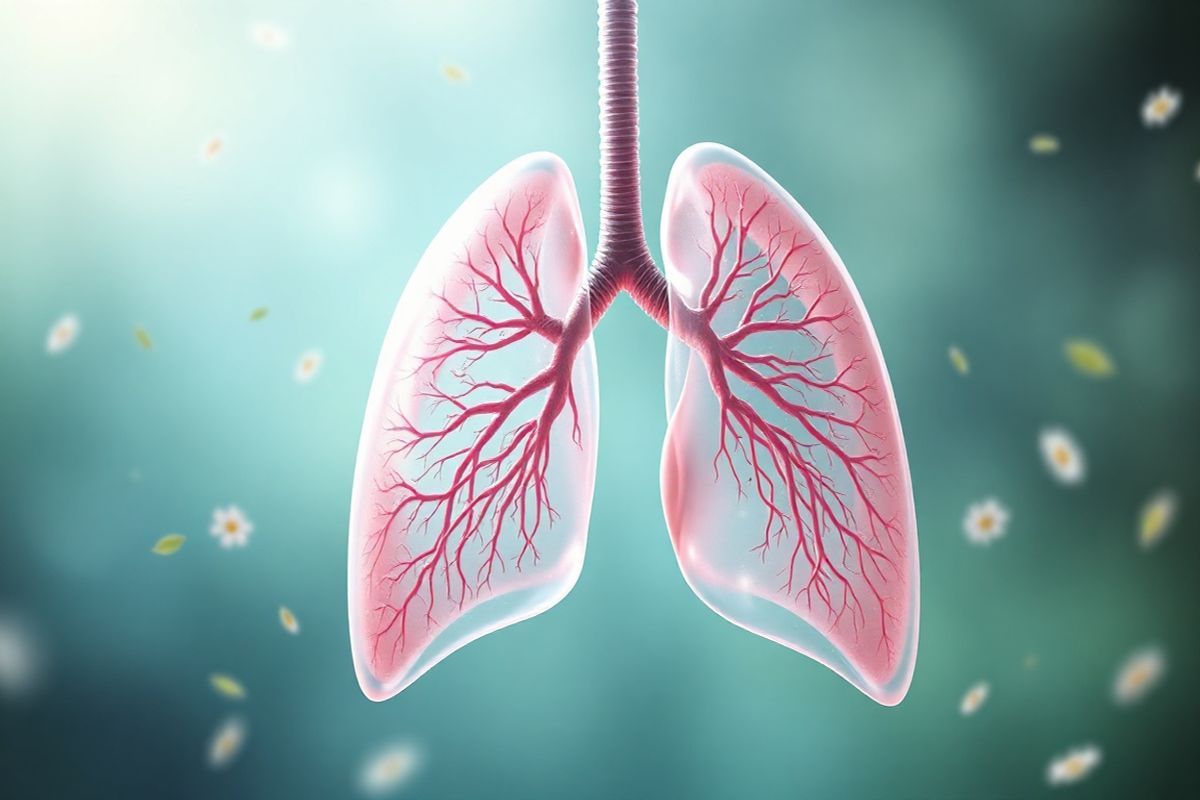Table of Contents
The Silent Struggle: What is Panlobular Emphysema and How Does it Fit into COPD?

Panlobular emphysema (PLE), also known as panacinar emphysema, is a specific type of emphysema that predominantly affects the entire acinus of the lungs. The acinus comprises the respiratory bronchioles, alveolar ducts, alveolar sacs, and alveoli, which are the structures responsible for gas exchange. In individuals with PLE, the walls of these air sacs become damaged and eventually rupture, creating larger air spaces and reducing the overall surface area available for gas exchange. This condition is part of chronic obstructive pulmonary disease (copd), which is a collective term for lung diseases that include emphysema and chronic bronchitis.
COPD is a major cause of morbidity and mortality worldwide, ranking as the fourth leading cause of death globally, responsible for approximately 3.5 million deaths in 2021, which is about 5% of all deaths (World Health Organization, 2023). In the United States alone, about 16.4 million adults have been diagnosed with some form of COPD, highlighting its prevalence (Verywell Health, 2023). Panlobular emphysema is characterized by uniform tissue damage throughout the acinus, which differentiates it from other types such as centriacinar and paraseptal emphysema, which affect different parts of the lung. Understanding PLE is crucial because it often indicates a more severe form of COPD and can significantly affect a patient’s quality of life.
Recognizing the Signs: Common Symptoms of Panlobular Emphysema You Shouldn’t Ignore

The symptoms of panlobular emphysema can vary widely from person to person, but several common symptoms should not be ignored. As the disease progresses, chronic damage to the airways leads to obstruction, making it increasingly difficult to breathe. Key symptoms include:
-
Shortness of Breath: This is often the most prominent symptom, especially during physical activities. Patients may initially notice this during exertion, but as the disease advances, it can occur even at rest.
-
Chronic Cough: A persistent cough, especially one that produces sputum (mucus), is common. This may be mistaken for a typical cough due to a cold or allergies.
-
Wheezing: A whistling or squeaking sound during breathing, particularly when exhaling, can indicate airway constriction.
-
Chest Tightness: Many patients report a feeling of tightness or pressure in the chest, which can accompany other symptoms.
-
Fatigue: As breathing becomes more laborious, patients often experience increased fatigue, making daily activities challenging.
-
Weight Loss and Loss of Appetite: Unintentional weight loss can occur, often due to increased energy expenditure while breathing.
-
Cyanosis: A bluish tinge around the lips or fingertips indicates low oxygen levels in the blood and requires immediate medical attention.
-
Frequent Respiratory Infections: Patients may experience increased susceptibility to respiratory infections due to compromised lung function.
-
Depression or Anxiety: The chronic nature of the disease and its impact on daily life can contribute to mental health issues.
Recognizing these symptoms early can lead to more effective management and treatment, slowing disease progression and improving quality of life.
The Roots of the Problem: Causes Behind Panlobular Emphysema and Its Connection to COPD
Understanding the causes of panlobular emphysema is essential for prevention and management. The primary factors contributing to the development of PLE include:
-
Cigarette Smoking: Smoking is the leading cause of all types of emphysema, including panlobular emphysema, accounting for 80% to 90% of cases (Healthline, 2023). The harmful chemicals in cigarette smoke damage lung tissues, leading to the destruction of the alveolar walls.
-
Alpha-1 Antitrypsin Deficiency (AATD): This genetic disorder results in low levels of alpha-1 antitrypsin, a protein that protects the lungs. Individuals with AATD are more susceptible to lung damage from environmental pollutants and smoke, leading to PLE (Verywell Health, 2023).
-
Environmental Factors: Long-term exposure to air pollutants, such as industrial fumes, chemical dust, and biomass fuels, can also contribute to the development of emphysema. Individuals who work in hazardous environments are particularly at risk.
-
Genetic Factors: Besides AATD, other genetic factors may predispose individuals to lung diseases, including emphysema.
-
Age and Gender: PLE typically develops in individuals over the age of 40. Males are generally more affected than females, although the gap is narrowing as smoking rates among women increase.
-
Other Lung Diseases: Conditions such as chronic bronchitis and asthma can exacerbate the risk of developing emphysema, particularly when combined with smoking.
Understanding these root causes can help patients take proactive steps to prevent the onset or progression of panlobular emphysema, particularly through smoking cessation and minimizing exposure to lung irritants.
Navigating Your Options: Effective Treatments and Management Strategies for Panlobular Emphysema
While there is currently no cure for panlobular emphysema, various treatment options can help manage symptoms, improve quality of life, and slow disease progression. The treatment plan may include:
-
Medications:
- Bronchodilators: These medications help relax the muscles around the airways, making breathing easier. They can be short-acting for immediate relief or long-acting for daily management (NHLBI, 2023).
- Inhaled Corticosteroids: These help reduce airway inflammation. They are often prescribed in combination with bronchodilators for individuals with moderate to severe COPD (Healthline, 2023).
- Antibiotics: Used to treat respiratory infections that can exacerbate symptoms of COPD (NHLBI, 2023).
-
Oxygen Therapy: For patients with low oxygen levels, supplemental oxygen may be necessary to ensure adequate oxygenation of tissues. This therapy can be used at home or in healthcare settings (NHLBI, 2023).
-
Pulmonary Rehabilitation: This is a structured program that includes exercise training, nutrition advice, and education about managing COPD. It aims to improve physical functioning and quality of life (NHLBI, 2023).
-
Surgery: In advanced cases, surgical options may be considered. These can include:
- Bullectomy: Removal of large bullae (air spaces) that can interfere with breathing.
- Lung Volume Reduction Surgery (LVRS): Removal of damaged lung tissue to improve overall lung function.
- Lung Transplant: For severely affected individuals, transplanting a healthy lung can significantly improve quality of life but carries substantial risks (NHLBI, 2023).
-
Lifestyle Changes: Quitting smoking is the most critical step for individuals with COPD. Additionally, maintaining a healthy diet, engaging in regular physical activity, and avoiding respiratory irritants can enhance overall health and lung function.
Treatment Overview Table
| Treatment Option | Description |
|---|---|
| Medications | Bronchodilators, corticosteroids, antibiotics |
| Oxygen Therapy | Supplemental oxygen to improve blood oxygen levels |
| Pulmonary Rehabilitation | Exercise and education program to enhance lung function |
| Surgery | Options include bullectomy, LVRS, and lung transplant |
| Lifestyle Changes | Smoking cessation, healthy diet, regular exercise |
Building a Healthier Future: Lifestyle Changes to Support Your Journey with COPD and Panlobular Emphysema
Adopting a healthier lifestyle plays a crucial role in managing panlobular emphysema and improving overall health outcomes. Key lifestyle changes include:
-
Quit Smoking: The most effective way to prevent further lung damage. Various cessation aids, including support groups and nicotine replacement therapies, can assist in quitting.
-
Nutrition: A balanced diet rich in antioxidants, vitamins, and minerals can support lung health. It is essential to maintain a healthy weight, as both obesity and being underweight can negatively impact lung function.
-
Regular Exercise: Engaging in regular physical activity can strengthen respiratory muscles and improve endurance. Consult with a healthcare provider to develop a safe exercise regimen.
-
Avoiding Pollutants: Minimize exposure to environmental pollutants and respiratory irritants, such as secondhand smoke and industrial fumes.
-
Vaccinations: Staying up-to-date with vaccinations, including flu and pneumonia shots, can prevent respiratory infections that can exacerbate COPD symptoms.
-
Stress Management: Techniques such as yoga, tai chi, and mindfulness can help manage stress and anxiety, which can worsen respiratory symptoms.
-
Support Groups: Joining support groups for individuals with COPD can provide emotional support and practical advice from others facing similar challenges.
Frequently Asked Questions (FAQ)
1. What is panlobular emphysema?
Panlobular emphysema is a type of emphysema that affects the entire acinus of the lungs, leading to lung tissue damage and difficulty breathing. It is a severe form of chronic obstructive pulmonary disease (COPD).
2. What are the main symptoms of panlobular emphysema?
Common symptoms include shortness of breath, chronic cough, wheezing, chest tightness, fatigue, weight loss, and frequent respiratory infections.
3. What causes panlobular emphysema?
The primary causes include cigarette smoking, genetic factors like alpha-1 antitrypsin deficiency, and exposure to environmental pollutants.
4. How is panlobular emphysema diagnosed?
Diagnosis typically involves a review of medical history, physical examination, lung function tests (such as spirometry), imaging tests (like chest X-rays or CT scans), and blood tests.
5. What treatment options are available for panlobular emphysema?
Treatment options include medications (bronchodilators, corticosteroids), oxygen therapy, pulmonary rehabilitation, and, in severe cases, surgery.
6. Can lifestyle changes help manage panlobular emphysema?
Yes, lifestyle changes such as quitting smoking, maintaining a healthy diet, exercising regularly, and avoiding pollutants can significantly improve quality of life for individuals with COPD.
References
-
World Health Organization. (2023). Chronic obstructive pulmonary disease (COPD) copd)
-
Verywell Health. (2023). Panlobular Emphysema: Diagnosis, Treatment, and More. Retrieved from https://www.verywellhealth.com/panlobular-emphysema-5120937
-
Healthline. (2023). Panlobular Emphysema: Causes, Symptoms, and More. Retrieved from https://www.healthline.com/health/panlobular-emphysema
-
National Heart, Lung, and Blood Institute (NHLBI). (2023). COPD - Treatment. Retrieved from https://www.nhlbi.nih.gov/health/copd/treatment











